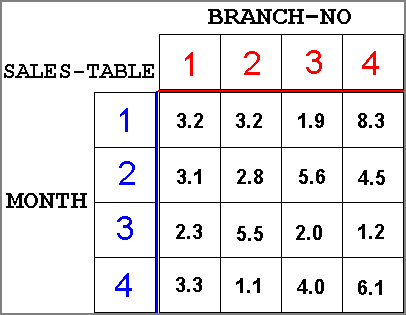Tables |
Also known as an array in other languages, a table is a
group of data associated with a single item name.
A D V E R T I S E M E N T
To identify pieces data (elements)
within that table the item is given a subscript number which follows the
name.
W-NAME (elements) Subscript
Smith 1
Jones 2
MacDoon 3
Walker 4
O'Leary 5
So, DISPLAY W-NAME (2) will give "Jones".
A 2-dimensional table uses two subscripts:

So element (2, 4) will contain "1.1".
To define the W-NAME (1-dimensional) table in the data
division:
01 W-NAME PIC X(10) OCCURS 5 TIMES.
The word TIMES is optional. Also, the PIC clause can also be written after the
OCCURS ... clause.
To define the SALES-TABLE (2-dimensional) table, just add
another level to the group. Hence:
01 SALES-TABLE.
03 BRANCH-NO OCCURS 4.
05 MONTHLY-SALES OCCURS 4 PIC 9V9.
|
Notice how only the top level 05 contains the PIC clause. Level 01 describes a
whole table made up of 4 items (level 03) containing 4 elements (level 05).
Table can be multi-dimensional, but always the last level
will be the identifier name that is associated with the subscripts and will have
the PIC clause.
For the use of tables, see the
League Table Program in the
Sample Code section.
Finally, don't try to refer to a table element that is of
a greater value than that defined in the data division, i.e. W-NAME (6) will
cause a runtime error and terminate the program. It should be obvious that a
subscript should be a numeric literal or an identifier that is numeric.
The use of identifiers as subscripts is where tables are
of most use, i.e. MONTHLY-SALES (INPUT-BRANCH, INPUT-MONTH).
